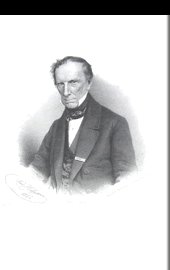A biography of Giovanni Battista Amici
1824-1827 - The achromatic microscope and the first trip to Paris and to London: Paris-  return to index
return to index
Amici carried out experiments with achromatic objectives as early as 1815, when he equipped his large aperture Newtonian telescopes with achromatic eyepieces. The best result, in his opinion, was with an objective composed of two convex lenses of French glass with a concave lens made of old English flint-glass in between. It was never, however, as good as his catadioptric microscope. He only began trying again in 1824, after reading the report given by Augustin-Jean Fresnel (1788-1827) at the Royal Academy of Sciences in Paris about the achromatic microscope developed by Alexandre François Gilles, called Selligue (Paris 1784-1845). Amici progressed the field beyond the work of Selligue and Chevalier because he demonstrated that in order to obtain a high resolution power the objective had to be composed by different parts whose aberrations were not totally eliminated, if taken separately, but calculated to neutralize reciprocally when combined (Van Cittert, 1947).
1824 is universally considered the year of the birth of the modern compound achromatic microscope.
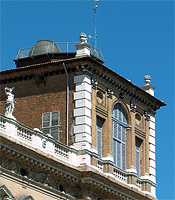 The new Observatory of Modena, built on the East Tower of the Palazzo Ducale, began to work in August of 1827. Amici had furnished it with a transit instrument with a 5 foot focal length, 4 inch aperture telescope and an equatorial telescope with two-foot diameter hour and declination circles. The first of these were divided every 4”, the other every 15”, and these divisions were made with a machine Amici had invented. He had also provided an 8 foot focal length, 6 inch aperture Newtonian telescope which had already been given to Giuseppe Bianchi in 1821, plus a double image micrometer for a Dollond telescope. Later he would also add a second Newtonian telescope, a catoptric Gregory telescope, a microscope with a camera lucida and a dividing machine (C. Bonacini).
The new Observatory of Modena, built on the East Tower of the Palazzo Ducale, began to work in August of 1827. Amici had furnished it with a transit instrument with a 5 foot focal length, 4 inch aperture telescope and an equatorial telescope with two-foot diameter hour and declination circles. The first of these were divided every 4”, the other every 15”, and these divisions were made with a machine Amici had invented. He had also provided an 8 foot focal length, 6 inch aperture Newtonian telescope which had already been given to Giuseppe Bianchi in 1821, plus a double image micrometer for a Dollond telescope. Later he would also add a second Newtonian telescope, a catoptric Gregory telescope, a microscope with a camera lucida and a dividing machine (C. Bonacini).
In the spring of the same year, with his wife, his son Vincenzo, Count Forni and his servant Luigi, Amici took his first trip to Paris and London. He brought with him the prism reflecting sector, the new double image micrometer and a reflecting mirror of 12 inches in diameter and a 20 foot focal length, commissioned by Frederik William Herschel for his friend the astronomer Reverend Hussey. He also of course brought catadioptric and achromatic microscopes which could be mounted on the same stand.
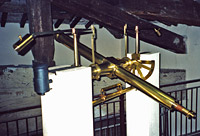 They reached Paris on 16 May. He met early on with one of the most important opticians of the French capital, Jacques Louis Vincent Chevalier (1770-1840). He had been corresponding with Amici since 1825 and had sent him glass and items for optics. Chevalier now told Amici that he had constructed an achromatic microscope according to Eulero’s theory. In another of his letters to Amici, addressed to the Hôtel d'Orléans in rue des Petits Augustins and dated 23 May, 1827, Chevalier wrote: “Quant à la bonté que vous avez en nous promettant de nous admettre à l’honneur de la construction de votre excellent microscope, nous vous reïterons, Monsieur, que c’est avec le plus grand plaisir que nous y mettrons toute l’exactitude et la célérité dont nous serons capables et que nous ferons avec vous, Monsieur, tous les arrangemens d’intérêt qui pourront vous être agréables. Pour ce qui est relatif à la fourniture des pièces essentielles (le fameux miroir Elliptique), dessins, modèles, Mémoires &c. vous aurez la bonté de nous les fournir”. Their relationship and the correspondence of Amici with the Chevaliers, both Vincent and his son Charles Louis (1804-1859) lasted until 1855.
They reached Paris on 16 May. He met early on with one of the most important opticians of the French capital, Jacques Louis Vincent Chevalier (1770-1840). He had been corresponding with Amici since 1825 and had sent him glass and items for optics. Chevalier now told Amici that he had constructed an achromatic microscope according to Eulero’s theory. In another of his letters to Amici, addressed to the Hôtel d'Orléans in rue des Petits Augustins and dated 23 May, 1827, Chevalier wrote: “Quant à la bonté que vous avez en nous promettant de nous admettre à l’honneur de la construction de votre excellent microscope, nous vous reïterons, Monsieur, que c’est avec le plus grand plaisir que nous y mettrons toute l’exactitude et la célérité dont nous serons capables et que nous ferons avec vous, Monsieur, tous les arrangemens d’intérêt qui pourront vous être agréables. Pour ce qui est relatif à la fourniture des pièces essentielles (le fameux miroir Elliptique), dessins, modèles, Mémoires &c. vous aurez la bonté de nous les fournir”. Their relationship and the correspondence of Amici with the Chevaliers, both Vincent and his son Charles Louis (1804-1859) lasted until 1855.
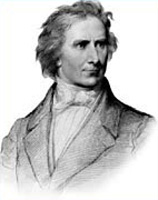 They also met the scientific instrument maker Henry Prudence Gambey (1787-1847); the physicist Alexandre Claude Martin Lebaillif (1764-1831) and the optician of the Observatory and of the French Navy Noël-Jean Lerebours (1762-1840). Amici was in contact with Lerebours’ son, Nicolas Marie Paymal (1807-1873), director of the Fabrique d’instruments d’Optique, de Physique, de Mathématiques et de Marine. N. P. Lerebours, from 1839 to 1844.
They also met the scientific instrument maker Henry Prudence Gambey (1787-1847); the physicist Alexandre Claude Martin Lebaillif (1764-1831) and the optician of the Observatory and of the French Navy Noël-Jean Lerebours (1762-1840). Amici was in contact with Lerebours’ son, Nicolas Marie Paymal (1807-1873), director of the Fabrique d’instruments d’Optique, de Physique, de Mathématiques et de Marine. N. P. Lerebours, from 1839 to 1844.
They saw Jean François Dominique Arago (1786-1853), physicist and mathematician, astronomer of the Observatory, professor at the École Polytechnique and later secretary of the Bureau des Longitudes; Charles-François Brisseau Mirbel (1776-1854), botanist, professor at the Jardin des Plantes and at the École Normale; Adolphe Théodore Brongniart (1801-1876), professor of Botany and Plant Physiology at the Natural History Museum and one of the founders of the “Annales des Sciences naturelles”; and probably Henri Milne-Edwards, at the time a 27-year-old student of Cuvier, who held Amici’s merits in the development of microscopic optics in high esteem. They also met André-Marie Ampère (1775-1836), professor of General and Experimental Physics at the Collège de France from 1824; the optician Robert Cauchoix (1776-1845); René Louiche Desfontaines (1750-1833), and others.
Vincenzo Amici wrote the following in his travel diary:
21. Papà and I went to see the instruments of Mr. Cauchoix this morning [...] He has beautiful objectives with up to 13 inches of aperture but which haven’t yet been worked on. He didn’t invite us to look through any of his telescopes because we told him that we can read letters from a distance of 1000 feet that he has never been able to read from the same distance. After lunch we went to a meeting of the Institute where we were presented to the president Mr. Brongniart by Mr. Arago [...] Papà was then presented to Legendre, Lacroix, Ampère, Dulong, des Fontaines, Cuvier, Mirbel, etc, all of whom were pleased to meet him and desirous to observe through his microscope. The Baron Cuvier has invited us to dejeuner next Thursday, and Arago has invited us for lunch the same day.
23. Mr. Gambey stayed for thee hours today to see our instruments. Mr. Arago came to take us to dejeuner with Mr. Cuvier where we saw the circulation in the Chara Hyspida and in the other species which des Fontaines calls flexilis but which looks more like Walroth’s pulchella. There were also Mr Ampère, des Fontaines, Mirbel and others whose names I cannot remember. We lunched with Mr. Arago at the Observatory together with Mr. Savary, Mr. Nicolet, Mr. Mathieu. Mr. Arago showed us the lovely compass by Mr. Gambey and an ingenuous little instrument by a German astronomer which makes the measure of the precession of the Equinoxes perceptible.
24. We were visited by Mr. Lebaillif and by his friend from Saulieu, by Sir di Blanville, by Mr. Turpin, etc. They observed in the microscope for a long time and were very surprised. Later Mr. Cauchoix and the young Mr. Chevalier arrived [...]
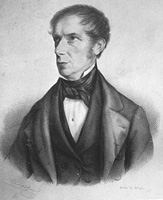 When he came back through Paris returning from London, Amici handed over his achromatic microscope to Brongniart. This latter had been very enthusiastic and he substituted the Selligue microscope that he had been using with Amici’s for his observations. Mirbel received a more improved model the next year. In this way the instrument moved into the foreground of investigations on the process of plant fertilization. As early as 1825, while presenting an account which the French botanist and naturalist Jean-Antoine Guillemin (1796-1842) had read on 21 March to the Académie des Sciences, the editor of the “Annales des Sciences Naturelles” (Vol. IV-1824,
When he came back through Paris returning from London, Amici handed over his achromatic microscope to Brongniart. This latter had been very enthusiastic and he substituted the Selligue microscope that he had been using with Amici’s for his observations. Mirbel received a more improved model the next year. In this way the instrument moved into the foreground of investigations on the process of plant fertilization. As early as 1825, while presenting an account which the French botanist and naturalist Jean-Antoine Guillemin (1796-1842) had read on 21 March to the Académie des Sciences, the editor of the “Annales des Sciences Naturelles” (Vol. IV-1824,
p. 350) claimed that
Le perfectionnement des instrumens d'optique, perfectionnement auquel MM. Amici et Selligue ont tant contribué, a fait sentir à plusieurs naturalistes la nécessité de vérifier et d'étendre les observations faites anciennement avec des instruments moins parfaits. M. Guillemin a appliqué l'excellent microscope de M. Selligue à l'étude du Pollen [...]
Brongniart was even more explicit in 1827, after having tried out Amici’s new achromatic microscope (Mémoire sur la Génération et les Développement de l’Embryon dans les végétaux phanérogames):
Je vais rapporter le peu de faits que j'ai sur ces trois questions, en engageant les observateurs qui auraient des instrumens plus parfaits, et surtout un microscope d'Amici à leur disposition, à diriger leurs recherches sur ce sujet [p. 43].
A little further on in the same issue of the “Annales des Sciences naturelles” is written (Notice sur quelques Observations microscopiques sur le Sang et le Tissu des animaux, par le docteur Hodgkin et J. J. Lyster, pp. 53-54; from the “Philosoph. Mag. & Annals of Philosophy”, Aug. 1827):
Le précieux microscope achromatique composé, que possède M. J.-J. Lyster, étant, à ce que je pense, bien supérieur à tous les autres instrumens de cette espèce fabriqués dans ce pays [England], je crois que quelques-uns des résultats obtenus par son application à la structure animal, pourront intéresser le lecteur. Ce microscope est le seul qui jusqu'à présent ait pu soutenir la comparaison avec le célèbre instrument d'Amici. Après bien des essais comparatifs faits sur les objets les plus délicats, il a été impossible de décider lequel des deux l'emportait en supériorité de celui de J.-J. Lyster, ou de celui que le célèbre physicien de Modène avait avec lui durant son dernier séjour dans ce pays, quoique ce professeur ait bien voulu accorder toutes les facilités possibles pour établir la comparaison.
Vincenzo continues in his diary:
25. Mr. Dulong and Mr. Savary came to our house this morning and remained from 9 to 12. Then Mrs. Arago came to visit. We spent the evening at the Cuvier house which is very formal, always with your hat in your hand, etc. We saw Mr. Prony, Mr. Jussieux and others there.
28. Many people came to see the microscope this morning: The Eduards, two English brothers, Mr. Brongniart son, Mr. Turpin, Mr. Lebaillif and his friend from Saulieu, Mr. Dumas, Mr. “Professor” [blank space] They confessed that they would need to begin many observations all over again and rectify them due to the huge difference between the instruments they have been using and those that we have brought with us. [...]
31. This morning Mr. Brongniart came to visit, as well as the older Mr. Eduard and a professor whose name we do not know. We observed molecules of human blood, and they were all surprised because they had never been able to see them so enlarged and so distinct. [...]
Bibliography
Henri Milne-Edwards, Leçons sur la physiologie et l’anatomie comparée de l’homme et des animaux, Masson, Paris 1857; Carlo Bonacini, La storia dell’osservatorio, in Nel Primo Centenario della Fondazione dell’Osservatorio 1827-1927, Modena 1927; P. H. Van Cittert and J. G. Van Cittert-Eymers, The Amici-microscopes about 1850 in possession of the University of Utrecht, “Proceedings of Koninklijke Nederlandsche Akademie van Wetenschappen”, vol. L-1947, pp. 553-563; G. Cadoppi, Gabinetti scientifici e strumentaria nel Ducato di Modena, “Giornale di Fisica”, 2/3-1988; E. Proverbio-P. Tucci, Giovan Battista Amici costruttore di telescopi e cannocchiali acromatici, “Physis”, 1-1993; A. Meschiari, Corrispondenza di G. B. Amici con ottici e meccanici (Buron, Chevalier, Duboscq, Ertel, Fraunhofer, Guinand e Feil, Hartnack, Lerebours, Merz, Nachet, Oberhaeuser), “Atti della Fondazione Giorgio Ronchi”, 4/5-2000.
![]() 1817-1823 | 1824-1827 (London)
1817-1823 | 1824-1827 (London) ![]()
